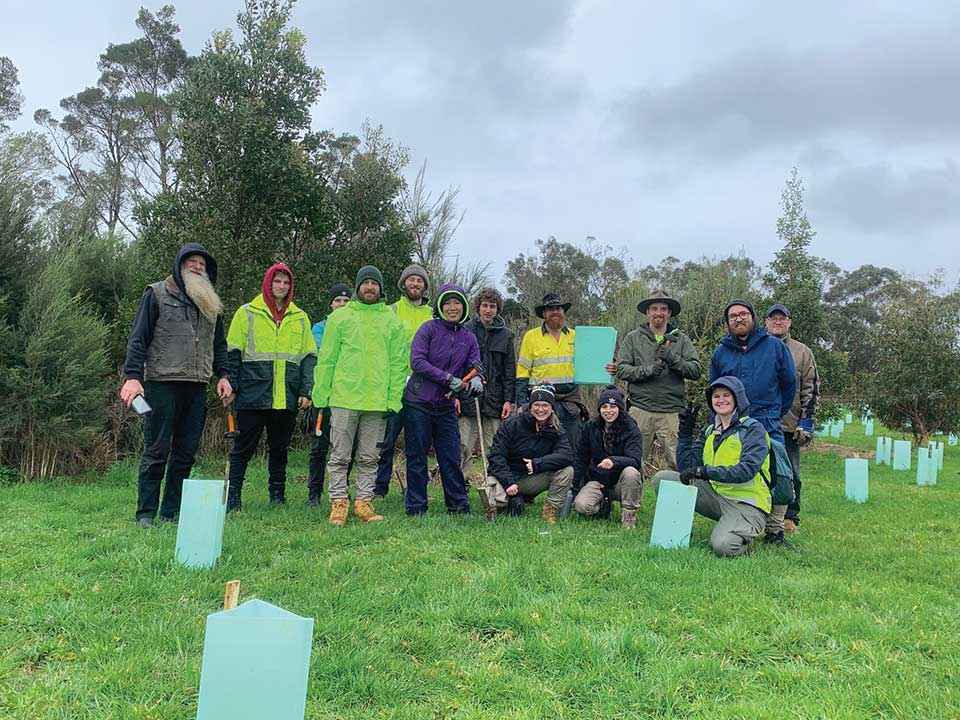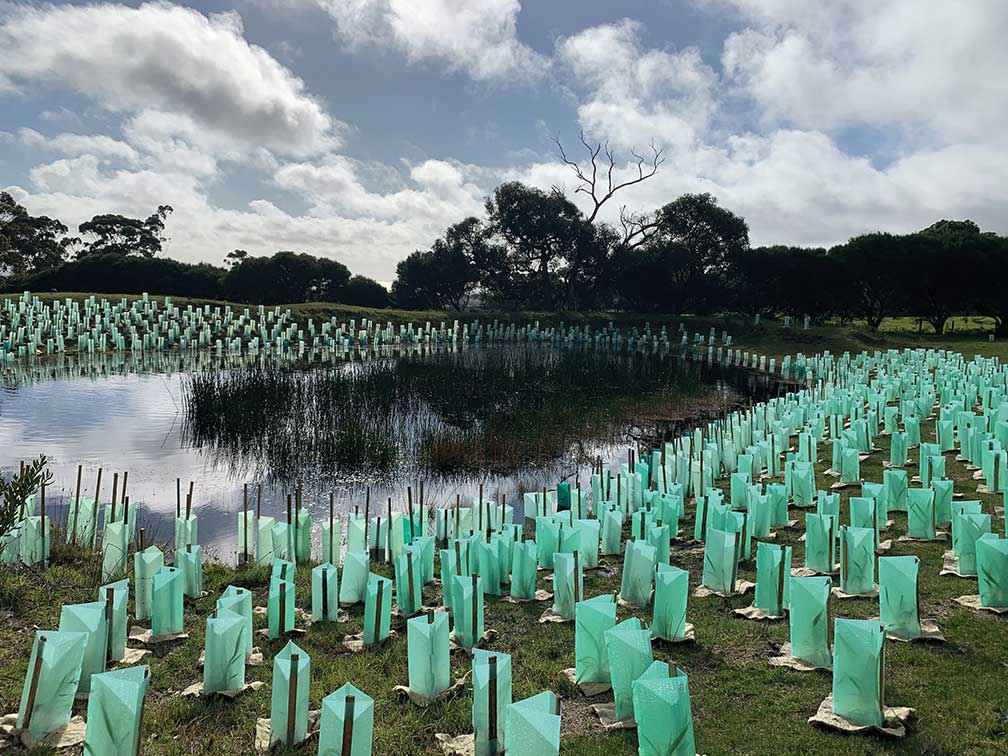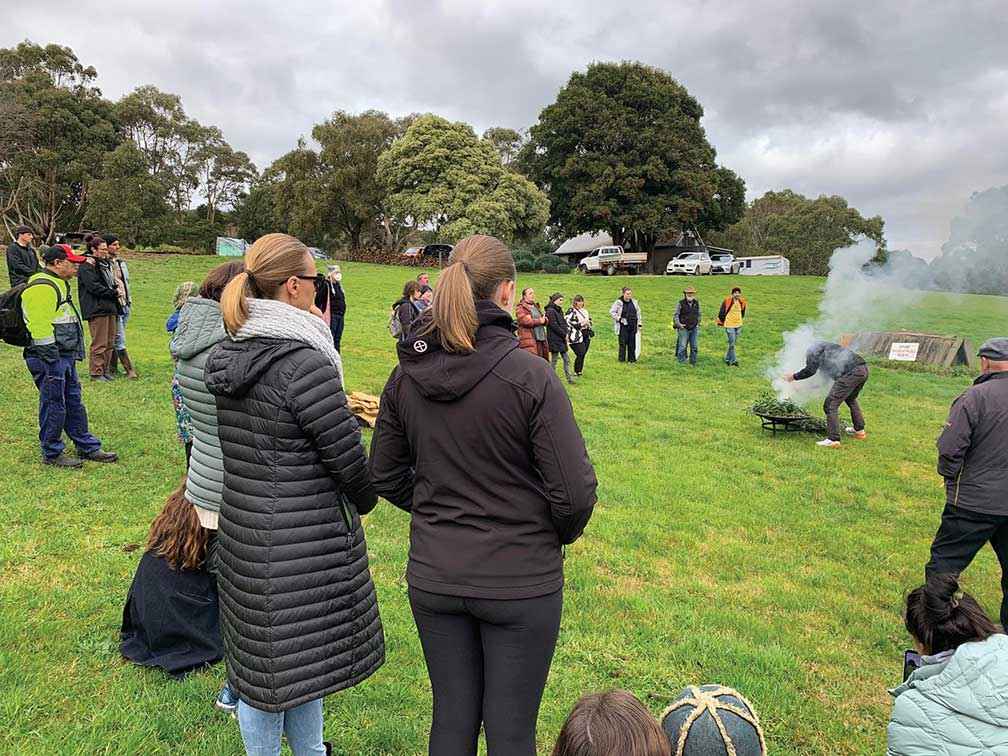Victorian Landcare Magazine - Spring 2024, Issue 88

The Mornington Peninsula Landcare Network (MPLN) is making good progress on its biolink from Mornington Peninsula National Park at Greens Bush to Arthurs Seat State Park.
These two large, core areas of remnant vegetation are being reconnected by a biolink that will improve catchment health and address the lack of landscape connectivity on the peninsula. The biolink will be formed across private property by revegetation and weeding and fencing of remnants. It will benefit numerous threatened fauna, including the powerful owl and swamp skink.
The project got underway in 2017 when MPLN received funding from the Victorian Government’s Our Catchments, Our Communities initiative to implement the biolink plans for Main Creek Catchment Landcare Group and Southwest Mornington Peninsula Landcare Group. These plans were developed through the Linking the Mornington Peninsula Landscape project.
Further grants from Our Catchments, Our Communities and several Victorian Landcare Grants along with a partnership with the (then) Port Phillip and Westernport CMA’s Work for Victoria Crew has seen the expansion of the biolink project. Eight land management plans have been developed for farms in the project area and many of the works identified in the plans are being implemented.
MPLN works directly with landholders along the proposed biolink route. Forty private properties have signed formal landholder agreements, becoming involved in the project in varying capacities. Adding to the benefit of the biolink, many properties are contiguous.
Revegetation has been undertaken on over 24 hectares across 15 properties, in partnership with local schools, tertiary institutions, Scouts and Girl Guides Australia and the wider community. A total of 830 volunteers have contributed to the planting of 27,500 indigenous plants so far. Local provenance tube stock is carefully selected when the plantings are on bare land that is unlikely to naturally regenerate on its own.

Above: Enhancing a farm dam with indigenous aquatic species to convert it to valuable habitat and help sequester carbon emissions along the biolink route at Boneo in 2021.
Removing weed infestations on more than 58 hectares of remnant vegetation across 23 private properties helped restore these valuable areas to better support native wildlife. Eligible landholders are encouraged to apply for Melbourne Water funding to control weeds along three high priority reaches of Drum Drum Alloc Creek, Splitters Creek, and Main Creek. This has led to kilometres of improved stream frontage and allowed biolink funds to be directed outside the riparian buffer.
Weeding control activities have been complemented by the Mornington Peninsula Shire’s annual roadside weed program. A Parks Victoria Good Neighbour Grant also enabled focused weed control in Mornington Peninsula National Park at Greens Bush.
Another highlight of the project has been installing nest boxes on properties with an absence of hollow bearing trees. A concerted effort with fox control has reduced predation pressure on many of the indigenous animals in the area.
Another highlight of the project has been installing nest boxes on properties with an absence of hollow bearing trees.
It has been important to record the project as the biolink progresses. We use drone footage or photo point monitoring at our sites before and after planting works. Gate signage on participating properties helps to highlight the project at street level and identify funding partners.
Engaging the community with field days and workshops has helped to educate and empower landowners to best manage their land to support wildlife. Workshops on native plant identification, sensitive weed control techniques, whole farm approaches to revegetation for biodiversity, climate resilience and productivity, and native bees as pollinators have been enthusiastically received.
Planting days and events have been a great way of involving the community. Hundreds of volunteers attend our National Tree Day plantings. In 2022 we ran a successful NAIDOC Week planting where we partnered with an Aboriginal organisation, Our Songlines, to carbon offset their Survival Day march held earlier in the year. The planting began with a Welcome to Country and smoking ceremony and ended with a hard-earned lunch provided by Indigenous owned Cooee Café.
It has been important to record the project as the biolink progresses. We use drone footage or photo point monitoring at our sites before and after planting works.
The success of this project is largely due to strong partnerships with key stakeholders, including Melbourne Water, Mornington Peninsula Shire, Parks Victoria, Birdlife Australia, Holmesglen TAFE, Advance College, Balcombe Grammar, Padua Secondary College, Flinders Christian Community College and Scouts Australia. In addition, the enthusiasm and generosity of community members keen to get involved and make a positive contribution to environmental values cannot be overstated.

Above: Welcome to Country and smoking ceremony marked our NAIDOC Week planting event with Our Songlines at Main Ridge
Nina Sharpe, representing Grow Corp Foundation at Main Ridge says the foundation is thrilled to be just one small link in the chain of the biolink.
“We were initially drawn to be part of the biolink as we saw a clear alignment with our overall goal to ensure private land gives back to the community and ultimately to nature, and to regenerate and improve biodiversity. MPLN have been a fantastic partner for us to work with. The support in planning, implementing and ongoing maintenance has been generous and supportive and will continue in our ongoing pursuit to regenerate. Planting days are an experience that brings people together around these goals. There we witness a beautiful sense of community, openness and connection,” Nina said.
Adrienne Smith, also from Main Ridge, appreciated being assisted with weed control after joining the project.
“As an older couple, we had reached the stage where our blackberries were overwhelming. We joined the biolink and two experts came out. While taking great care of precious indigenous flora, they sprayed the canes which then died slowly in place. Today we have natural regeneration where once there were blackberries. A great outcome,” Adrienne said.
The future focus of the project is to secure and expand the biolink. As the project continues to grow we will achieve even greater connectivity in the landscape to provide viable linkages for indigenous flora and fauna, promote overall catchment health and responsible land stewardship now, and for future generations.
Chantal Morton is Landcare Facilitator with MPLN. Her position is funded through the Government’s Victorian Landcare Facilitator Program. For more information email facilitator@mplandcare.org.au